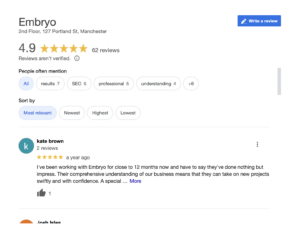
Top tips for handling negative reviews

The importance of reviews
As a business receiving feedback from stakeholders such as colleagues and clients is key to development and business success. It’s been found that 95% of customers read reviews before making a purchase online and over 81% of consumers check Google reviews first. So it’s clear to see why getting and managing reviews is important to your brand and marketing strategy.

Now of course, positive feedback and reviews are essential for your business growth, however, you can’t take the good without the bad. Negative reviews are inevitable, and with the internet and social media handling them correctly is key for managing your brand reputation and marketing.
Fortunately, we have detailed a number of ways you can handle negative reviews and use them to develop your business and limit the impact they can have.
6 ways to handle negative reviews
1. Respond promptly
When it comes to negative reviews, time is of the essence. Data shows that 95% of unhappy customers will shop again with a company if it solves the issue in a quick and efficient manner.
Sometimes it can be daunting to know how to respond to negative comments, and there could be fear that you will antagonise the reviewer and matter further. However, likewise, no response can also make the customer think you don’t care, resulting in them leaving more negative reviews on different platforms and escalating the problem for your brand.
Review Trackers found that 1 in 3 consumers expect brands to respond to negative reviews in less than 3 days. So even if you’re unsure what to say exactly within that time then we recommend using just a holding message like ‘We’re sorry to hear this, we will look into the matter and come back to you’. A response like this can also provide you with an opportunity to move the conversation away from the wider public.
2. Stay calm and professional
Receiving negative feedback and reviews can be tough, especially if you don’t necessarily agree with the comments. The key thing here is that whilst you might not agree, it doesn’t mean you should disregard the review or feedback. Acknowledge the review, respond appropriately and then decide how to take action to best benefit your business. Remember you don’t have to publicly explain what action you plan to take, just acknowledging the reviewer can sometimes be enough to control the situation.
3. Take the conversation offline
The best thing to do when you get a negative review is to navigate the conversation offline so you can handle the matter privately. When you have acknowledged the review you should ask them to send more information to an email address or find a way to contact them directly that isn’t available for everyone to see the communication.
4. Offer a solution
When dealing with a negative review you should always look to provide a solution. Now what the solution is and how you offer it, is up to you and what’s best for you and your brand. Most often it’s best to respond and offer a solution privately, that way you don’t have other people seeing exactly what you provide in certain situations.
For example, if a customer leaves a negative review and you then offer them a discount code or a refund publicly, other users could use that discount code or even start requesting refunds which will impact your finances.
5. Be authentic and sincere
A key thing to remember when it comes to negative reviews is understanding how the reviewer feels and considering the feelings or actions that have led to them leaving the review. Too often you see brands handle negative reviews by getting frustrated and then responding in what can come across as a sarcastic or passive-aggressive manner, which of course doesn’t end well. Remember your response should be authentic to your brand and values but also show that you understand the reviewer’s point of view.
6. Learn from experience
When it comes to negative reviews it doesn’t all have to be bad. Instead, you can use it as an opportunity to learn and improve your business. Perhaps someone has had a negative experience that has allowed you to identify a failure in a process or product that you weren’t aware of.
Handling positive reviews
Don’t forget, that whilst you manage your negative reviews, you should also dedicate time to your positive reviews. Acknowledging and thanking those clients and stakeholders who have taken the time to give you good feedback, you could also reward them with an offer as a thank you.
You will also want to showcase those good reviews as they can be extremely powerful for your marketing and increase leads and sales.
How to get more reviews
`With there being so many benefits of reviews, you want to ensure you consistently receive them, and ideally of a more positive than negative sentiment. Here are just a few suggestions on how your business can increase its reviews:
- Go above and beyond – offering exceptional customer service will increase your chances of getting reviews. If customers feel like you really care and have exceeded their expectations they’re more likely to shout about it.
- Make it easy – customers are more likely to leave you a review if it’s an easy and simple process. When asking for reviews be sure to link customers directly to where they need to do it, and if it’s a form you’re asking them to complete then keeping it short and simple is best.
- Give them an incentive – perhaps you offer a discount code or a chance to win a prize for leaving a review. You just need to be careful how often you do this though, as you don’t want it to look like you’re ‘buying’ positive reviews.
Conclusion
So there you have six ways to handle negative reviews and turn them into opportunities to connect with your audience and improve your business. Also don’t forget to continuously gain reviews and showcase your positive feedback!
- Want to know more about online reviews and incorporating them into your marketing strategy? Take a look at these resources:
- The impact of reviews on local SEO
- How to get Google reviews
- 33 review sites to collect customer feedback



